![]() A novel technique for compact accelerators
A novel technique for compact accelerators

Conceptual Design of the AWAKE experiment at CERN. The major elements of the experiment are shown and the expected effects are described.
Image credit: CERN.
Circular electron colliders are not feasible at TeV energies; hence future TeV accelerator designs are based on linear colliders. However, as the beam energy increases, the scale and cost of conventional machines become very large. New acceleration technology is mandatory for the future of particle physics, to build more affordable and compact accelerators for various applications (e.g. medical). A rapidly developing, promising candidate is the Plasma Wakefield acceleration.
Plasma acceleration is a novel technique for accelerating charged particles using an electric field associated with electron plasma wave or other high-gradient plasma structures. A Proton Driven Plasma Wakefield Acceleration Experiment has been proposed as an approach to use high-energy protons to drive a plasma wakefield in a single plasma section for an electron beam acceleration to the TeV energy range.
To verify this novel technique, AWAKE has been launched at CERN as the first proton-driven wakefield acceleration experiment worldwide, using 400 GeV proton bunches from the CERN SPS. First beam to the plasma cell is expected for end 2016. The result of AWAKE will have a strong impact on future larger-scale R&D projects on proton-driven plasma wakefield acceleration and could open a pathway towards a revolutionary plasma-based TeV lepton collider.
AWAKE experts are working closely together with experts from the Novel Acceleration Techniques (ANAC2) Work Package of EuCARD-2. The goal of task 13.4 of this WP is to develop concepts for the instrumentation of the plasma cell that can have a length of 10s of meters.
![]() Accelerator neutrinos are recovering their lead
Accelerator neutrinos are recovering their lead
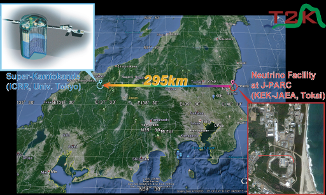
Fig:Overview of the T2K experiment in Japan. Image credit: T2K collaboration.
On July 19th 2013, the international T2K collaboration proudly announced definitive observation of muon neutrino to electron neutrino transformation. “This T2K observation is the first of its kind”, stated the collaboration in a press release, underlying that the probability for random statistical fluctuations to produce this result was less than on in a trillion.
In order to get to this result, the T2K experiment used data collected from the world’s largest underground neutrino detector, Super-Kamiokande, located in Japan. A muon neutrino beam was produced in the Japan Proton Accelerator Research Complex (J-PARC) and sent 295 km away to Super-Kamiokande, where its composition was studied and compared with the initial one.
Observation of this new type of neutrino oscillation opens the way to new studies - only possible with accelerator neutrinos - of charge-parity (CP) violation, which provides a distinction in physical processes involving matter and antimatter. CP violation in neutrinos in the very early universe might explain one of the most profound mysteries in science: the domination of matter over antimatter in our universe.
The T2K experiment is operated by an international collaboration, gathering over 400 physicists from 59 institutions in 11 countries.
![]() Exploring the accelerator frontiers
Exploring the accelerator frontiers
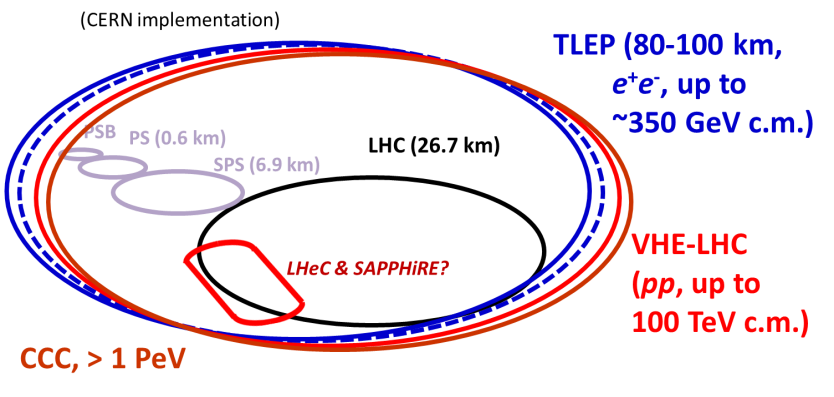

Fig 1: Schematic of a sequence of circular high-energy colliders after the LHC consisting of LHeC-SAPPHiRE, TLEP, VHE-LHC and CCC. Image credit: CERN.
Fig 2: Possible long-term strategy based on sequence of linear colliders. Image credit: CERN.
Discussing technologies and limits for future particle accelerators is key to defining a coherent long term strategy. In 43 workshops (co-)organized by EuCARD WP4 AccNet between 2008 and 2013, experts from all around the world drafted an R&D roadmap for the next 50-100 years.
Going beyond the state-of-the-art requires novel materials supporting higher magnetic or electric fields for acceleration or bending, e.g. stronger superconductors, dielectrics, plasmas or crystals. Energy efficiency and cost effectiveness are also becoming ever more important.
Taking into account emerging technologies, EuCARD WP4 delivered a coherent long-term vision for highest-energy circular colliders (Fig. 1). Encompassing a high-luminosity e+e- Higgs factory (TLEP or LEP3) and a 100-TeV proton collider (VHE-LHC), this approach could culminate in a circular crystal collider (CCC), boosting the c.m. energy to 1 PeV or beyond. An alternative “linear” approach (Fig. 2) would start with an ILC utilizing SC cavities, continue with CLIC, be followed by dielectric and plasma lepton colliders, and terminate with a linear x-ray crystal muon collider (XRCMC).
Remarkably, both linear and circular approaches require crystals to reach 1 PeV – for either acceleration or bending. Since crystals have been used only for bending so far, the circular route might be easier to follow. An ultimate limit is imposed by the Sauter-Schwinger critical field, constraining the minimum size of a Planck-scale collider to ~1010 m in either approach.
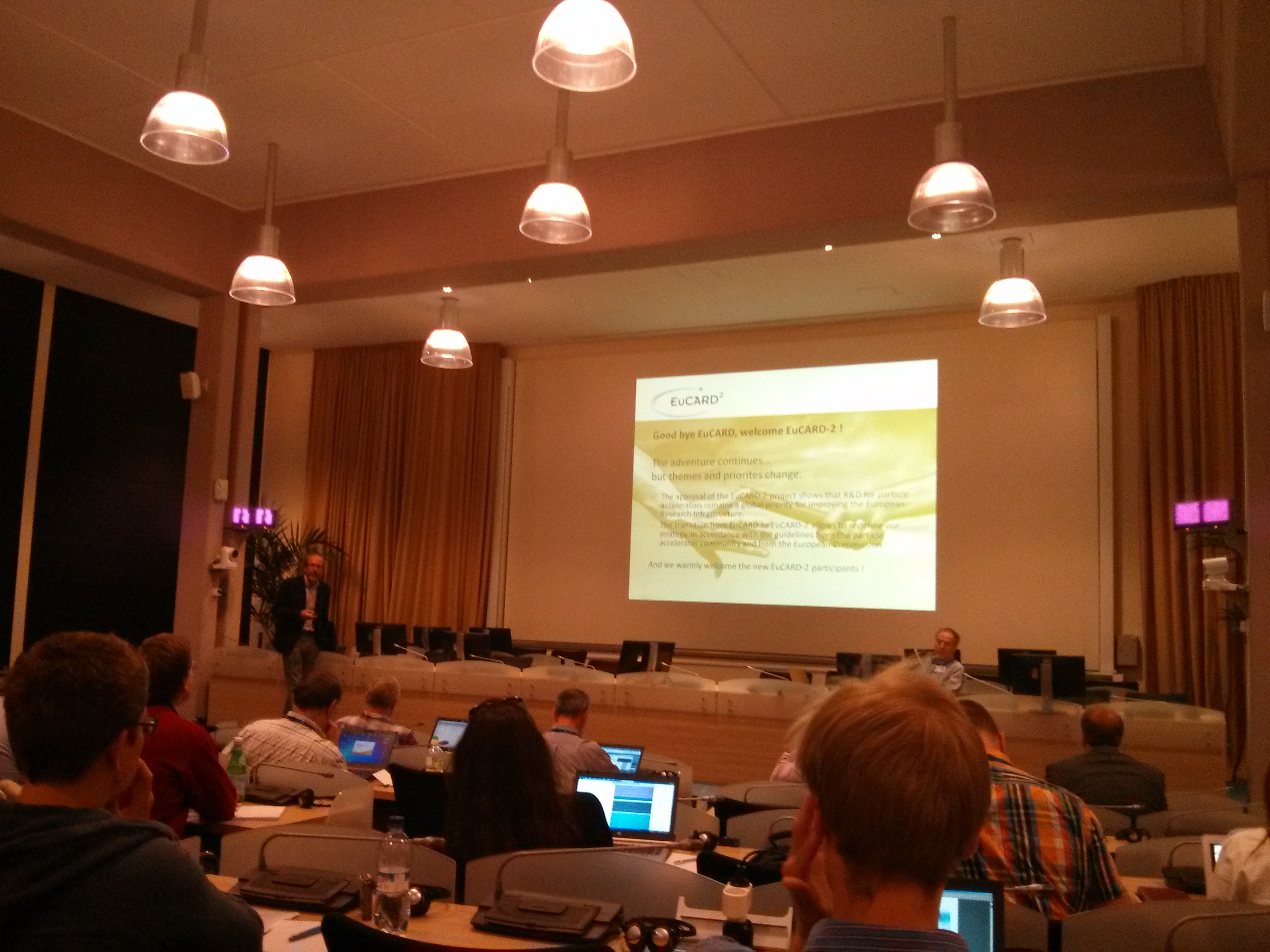
EuCARD-2 kick-off meeting in the Council Chamber at CERN. Image credit: CERN.
The EuCARD'13 annual meeting took place on 10-14 June at CERN. The event, which brought together more than 180 accelerator specialists from all over the world, drew the conclusions from the EuCARD project and kicked-off its continuation, EuCARD-2.
EuCARD-2 officially started on 1st May 2013 and will run for four years. With a total budget of 23,4M, including 8M of EU contribution, it will build upon the success of EuCARD and will push it into an even more innovative regime. EuCARD-2 brings a global view to particle accelerator research in order to address challenges for future generation of accelerators. By promoting complementary expertise, cross-disciplinary fertilisation and a wider sharing of knowledge and technologies throughout academia and with industry, EuCARD-2 aims at significantly enhancing multidisciplinary R&D for European accelerators, actively contributing to the development of a European Research Area in accelerator science.
![]() Thin films for Superconducting RF
Thin films for Superconducting RF

Pb-coated photocatode plug, and global view of the 1.5-cell 1.3 GHz cavity used for testing. Image credit: CERN
The activity led by CERN in close collaboration with several other laboratories (CI-Lancaster, CEA, CNRS-IPNO, DESY, SINS) within the EuCARD Work Package 10.4 aims to address diverse topics in the thin film technology applied to SRF.
The analysis of the relative merits of several state of the art thin film coating technologies and the establishment of a network of SRF thin film test facilities were the first goal of this activity. The second goal was the establishment of state of the art Nb/Cu deposition on QWR cavities by sputtering techniques, including also the novel HIPIMS technique which has been demonstrated first on elliptical cavities. The third goal was the successful demonstration of the compatibility of arc-coated Pb photocathodes with the stringent requirements needed for achieving high surface fields, when used in conjunction with state of the art Nb superconducting cavities.
The several positive results obtained in this task have led to the establishment of two new tasks in EuCARD-2, which are devoted to the further development of innovative thin films (multilayers, HIPIMS, new materials) and of photocathode manufacturing processes.
Read more >> [1] [2]
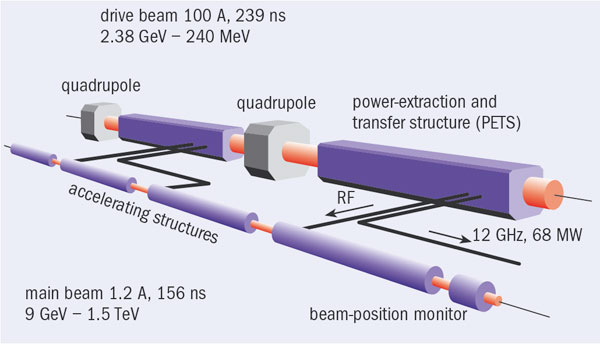
In a two-beam system, the RF power is provided by the drive beam to the main beam accelerating structure. Drive Beam timing errors must be avoided to maximize the acceleration gradient uniformity in the accelerating structures, and consequently to stabilize the Main Beam energy and optimize the collider luminosity. Image credit: CERN.
Extremely precise beam phase control is required for CLICtwo-beam acceleration technology as well as in Free Electron Lasers (FELs). The development of beam arrival time measurement systems has been carried out within Task 5 of the EuCARD Work Package 9, in collaboration with CERN, INFN/LNF and PSI.
In CLIC the Main Beam must be precisely synchronized with respect to the RF power produced by the Drive Beam. Timing errors would have an impact on the collider performance. The Drive Beam phase errors should be controlled, by means of a feed forward system, within 0.1Рat 12 GHz, corresponding to a timing stability below 23 fs, to avoid a luminosity reduction larger than 2%. A prototype of such a system is being installed in the CLIC Test Facility CTF3 and the performances of the beam phase arrival monitor have been already successfully tested.
FELs also require a tight synchronization of the beam with respect to photo injector lasers, RF and other systems. The beam phase measurement has been pursued at PSI with a different approach based on electro optical modulators. It has the advantage of very high band width, allowing the measurement of individual bunches arrival time with a potential resolution below 10 fs. The system was tested and the performance with beam validated at the PSI FEL test injector.
![]() Mechanical stabilisation of CLIC quadrupoles to the sub nanometre
Mechanical stabilisation of CLIC quadrupoles to the sub nanometre
by Kurt Artoos (CERN)
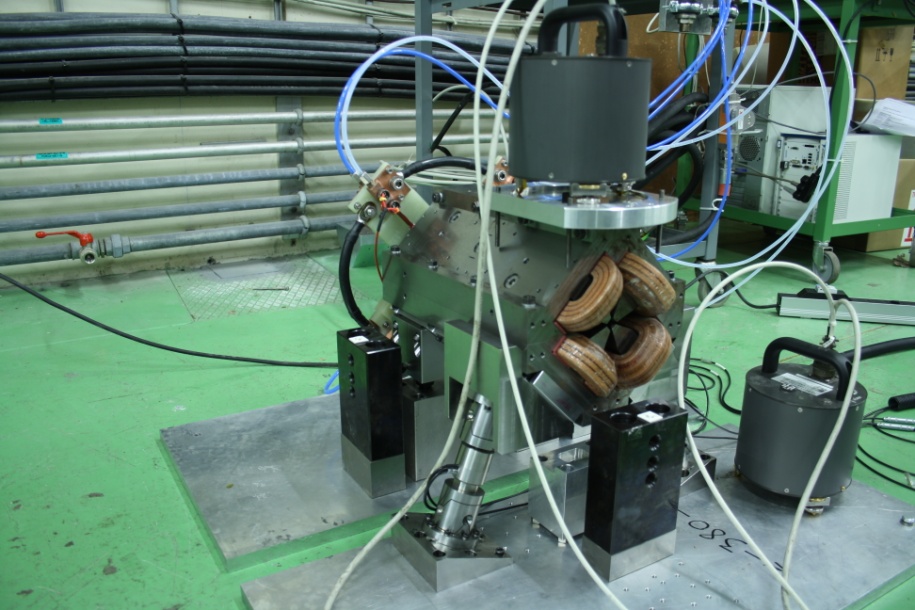
A CLIC Main Beam Quad prototype on two stabilisation actuators.
Image credit: CERN
In order to reach the luminosity of 2.1034 cm-2m-1 in CLIC, the cross section of the colliding particle beams at the interaction point will be in the order of the nanometre. Quadrupole magnets are used as focusing elements to keep the beam size small along the full accelerator length and to focus the beams to the collision point
Mechanical vibrations transmitted to the quadrupoles will however create small dynamic displacements of the magnets, resulting in a gradual increase of the beam size along the accelerator and jitter of the beam at the interaction point.
Vibration stabilisation systems were developed and successfully tested both at CERN and at LAPP Annecy under EuCARD WP9 framework. The level of vibrations of the quadrupoles is decreased by the systems to values smaller than a nanometre. The calculated gain in luminosity obtained by this vibration reduction is significant. The magnets are placed on vibration isolating supports based on piezo-electrical actuators that will reduce the vibrations measured by seismometers placed on the ground and on the magnet. The same actuating support makes it also possible to make very precise adjustments to the magnet. A precision of a quarter of a nanometre was already demonstrated on a prototype.
During 2013, new full scale prototypes will be constructed in order to move from a laboratory set-up to an accelerator component, integrated with other technical systems. Improved vibrations sensors are being developed.
![]() Development and Testing of Crab Cavities for High Intensity Colliders
Development and Testing of Crab Cavities for High Intensity Colliders


Fig 1: CLIC ‘Undamped’ Crab Cavity Fabricated.Image credit: Shakespeare Engineering Ltd (UK)
Fig 2: LHC 4-rod Crab Cavity Fabricated. Image credit: Niowave Inc (USA)
The development of innovative crab cavity solutions for high intensity particle colliders is part of both the FP7 EUCARD and HiLumi framework programmes.
The activity has been led by Lancaster University and STFC in the UK, in direct collaboration with CERN. For LHC, a compact Superconducting RF (SRF) solution at 400 MHz, capable of fitting into the confined space available at the LHC interaction regions is proposed. A compact TEM type deflecting structure has been manufactured at Niowave from bulk Niobium, which has been tested in SM18 at CERN, reaching a surface magnetic field of 33 mT (limited by a serious LHe leak). This represents the world's first high field test of a compact SRF deflector and the cavity is currently undergoing additional BCP processing in order to reach the LHC design gradient of 6 MV/m (Bpk~70 mT).
For CLIC, a high gradient 12 GHz, normal-conducting travelling-wave structure, with a high group-velocity to minimise the effects of beam loading, has been developed. Two ‘undamped’ structures have been fabricated, one in the UK by Shakespeare Engineering Ltd and the other at CERN. Systematic high gradient tests are planned at SLAC and CERN, to study breakdown differences between deflecting and accelerating structures. A third ‘damped’ cavity is currently being developed to allow verification of the operational performance. A high phase stability control system, which will keep the phase from a klystron stable over long distances, is also in development to meet the stringent CLIC phase stability tolerances.
![]() High Temperature Superconductors in the LHC
High Temperature Superconductors in the LHC

Maquette of High Temperature Superconducting Link of the type needed at LHC Point 7. Image credits: CERN
Superconducting links in accelerator systems enable powering of the cryo-magnets from remote power converters. The development carried out within Task 5 of the EuCARD Work Package7 aims at providing such technology for the remote powering of LHC magnets.
The use of High Temperature Superconductors (HTS) in Superconducting Links has the great benefit of enabling the development of a powering system where superconductors can be operated with a generous temperature margin. To enable the use of superconductors with tape geometry, a novel concept of cable optimized for DC electrical transmission (Twisted-Pair Cable) has been developed and demonstrated [1], [2]. A cabling machine enabling the controlled assembly of km-long Twisted Pair cables - made from superconductors with different mechanical characteristics - has been conceived, assembled and commissioned at CERN. A full-scale 5 m long prototype link has been made at CERN and successfully tested in nominal conditions at the University of Southampton [3]. A 20 m-long full scale link is being assembled at CERN, where it will be tested in nominal and transient conditions.
The main outcomes of this activity are: (1) the development of a novel concept of superconducting cable for electrical transmission that can be made from any of the HTS tape-conductors today available (BSCCO 2223, YBCO or MgB2); (2) the development of a new cabling machine for the controlled assembly of the cable; (3) the development of a full superconducting link system that could be used at LHC Point 7 for the powering of the superconducting magnets. The developed technology could be applied for feeding any superconducting system requiring currents in the 1 kA range at any temperature from liquid nitrogen to liquid helium.
![]() Targeting the Energy Frontier for next Accelerators
Targeting the Energy Frontier for next Accelerators
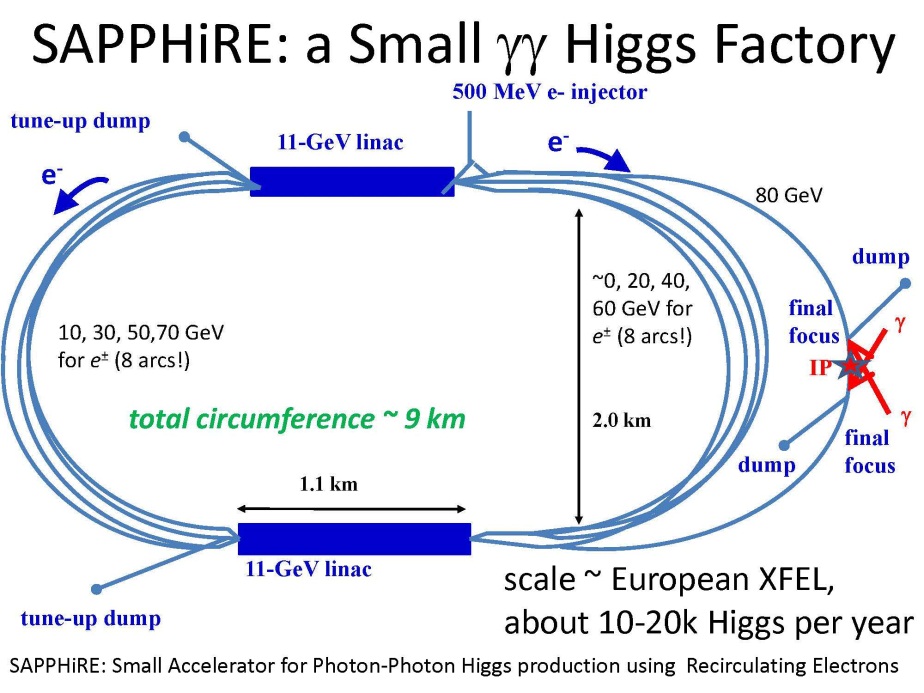
Layout of SAPPHiRE g-g collider Higgs factory delivering 10k Higgs per year.
Recently two EuCARD-AccNet events explored options for the next accelerators at the energy frontier. The EuCARD “SAPPHiRE Day” on 19 February focused on the key components of a proposed g-g collider Higgs factory, based on a recirculating SC linac. The “Joint Snowmass-EuCARD/AccNet-HiLumiLHC meeting on Frontier Capabilities for Hadron Colliders 2013” on 21-22 February investigated the next generations of hadron colliders up to the 100 TeV scale. Both workshops attracted about 50 experts from around the world.
The proposed SAPPHIRE layout is a moderately expensive step towards a higher-energy linear collider, demonstrating the handling of 20-nm spot sizes while delivering first-rate physics results. The emphasis of the SAPPHiRE Day was on the laser system, optical cavity, interaction region design, and FEL approaches.
The joint workshop on frontier capabilities explored the parameters and 20-T magnets for a 33-TeV c.m. pp collider in the existing LHC tunnel and for a 100-TeV c.m. collider in a new 80-km tunnel. The workshop reviewed the high-field magnet development status and plans at CERN and LBNL.
